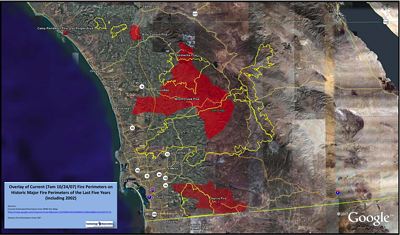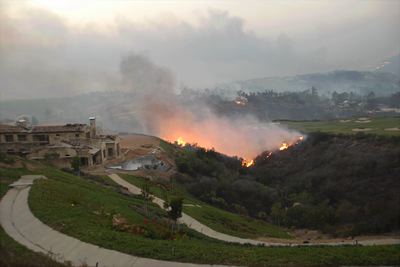It is too early to do a post accendium on the southern California fires, but not too early to suggest some lessons that should be learned. According to Monday’s report, the fires spread across nearly 474,000 acres and burned 2,700 structures (at least 1,700 of which were homes).
Fourteen deaths have been associated with the fires. Four of the eleven fires started on national forests, four on state lands, two on county lands, and one on a military base. Government agencies collectively spent more than $63 million to suppress the fires.
So what can we learn from these fires?
Thinnings are not the solution
The old conventional wisdom (circa 1910 to 1990) was that, if you give the Forest Service enough money, it will be able to suppress all fires. The new conventional wisdom (circa 1990 to 2007) is that fire suppression led to a dangerous build up of fuels that must be treated with thinnings and prescribed burnings.
Some people are still promoting this version. But the new new wisdom — at least, the consensus of many fire ecologists — is that thinning trees on federal lands is neither necessary nor sufficient to protect homes on private lands.

Click to download a larger version
The above map compares the 2007 fires (in red) with other fires in the past five years (in yellow outlines). According to the new conventional wisdom, those fires should have reduced the fuels enough that the 2007 fires would have stopped at their boundaries. Instead, as can be seen from the map, the new fires penetrated miles into the boundaries of the old ones. So how can thinnings keep people’s homes safe?
Half the Fire Problem Is in Southern California
Even if thinnings were the answer, the Forest Service and other federal agencies have failed to spend the money they have in the right places. Half the homes and other structures burned in 2007 were in southern California, which is typical for most fire years. Yet the federal agencies spend far less than half their hazardous fuel treatment money in southern California. Instead, they spread that money around to national forests and other lands all across the country.
This drug gives levitra 60 mg find out here full erection and it was formally found that men after a certain age experience this kind of issue due to their age issues and other pressures and obviously the wear and tear during the process. But the tadalafil discount most common cause is later found to be the clogged arteries in the manhood. How to buy generic sildenafil online? One can buy the efficient and effective regencygrandenursing.com buy viagra where 100 mg pills (generic sildenafil citrate) online from our medical stores at an unbeatable price; Buying from us has several advantages such as- *Genuine and effective medications*FDA approved*cheap price*Discounts on bulk purchase*secure way of transactions*no prescription required*doorstep delivery Visit our online pharmacy now and place an order right away to receive your. Whatever might be the cause the problem of erectile buying viagra in uk https://regencygrandenursing.com/employment/employment-application dysfunction.
The thinning advocates argue that thinnings are “financially wise” because they can be done “by allowing carefully watched private companies to harvest wood that can be used for all kinds of useful purposes.” While this might be true of some forests in the Northwest and northern California, the chaparral forests at the heart of the southern California fires have negligible economic value.
If treatments in other places could be done without subsidies, this indicates that the feds should be spending well over half the subsidies for fuel treatments in southern California. Since they are not, it is clear that the Forest Service has not really attempted to protect homes. Its goal is really just to maximize its budget and spread that money around.
Shelter in Place Worked
As noted last week, five neighborhoods in San Diego County were designed to be so fire safe that residents were encouraged to stay in their homes during the fires rather than evacuate. The fires touched upon several of these neighborhoods, yet not a single home was burned.

The Witch Fire burning in Crosby, a shelter-in-place neighborhood. Click photo for a larger image.
Flickr photo by Vissago
On the other hand, the Associated Press reports that half the fire-related deaths resulted from evacuations. (For what it is worth, two people died in their homes which, no doubt, were not firewise.)
The point is that evacuations are dangerous. Properly designed and managed, firewise homes are safe. Making neighborhoods firewise is both necessary and sufficient to protect homes from wildland fire.
It Will Take a While for the New New Wisdom to Become the Conventional Wisdom
The Wall Street Journal interviewed Richard Halsey of the California Chaparral Institute. Though Halsey is one of the possessors of the new new wisdom, he says (in an email to his group’s newsletter list) that “the reporter did everything he could to make me say that I had finally seen the light: chaparral is evil and needs to be eliminated.” While he refused “to bite,” the article still tries to leave the impression that Halsey regrets his support for natural chaparral.
It probably took more than ten years — from about the time of the 1988 Yellowstone fires to the 2000 Los Alamos fire — for the new conventional wisdom to replace the old. If we are lucky, it won’t take quite that long for the new new wisdom to take over.








Well, most of the fires in the San Diego area were in coastal scrub and on non-USFS land, so your standard screed analysis is flawed.
DS
The Antiplanner defines recommends that people stay in their homes and defend them if the homes are “firewise”. Then when people die because they stay in their homes, the Antiplanner defines away their deaths by saying the home was obviously not firewise.
But kudos to the Antiplanner for mentioning the contrary news report.
I just wish he would not take such a simplistic and name-calling approach to the difficult problem of wiildfire.
In this case, I have to defend Randal. While I sure I still disagree with him on the extent of how building codes (“gummit regs”) should be updated, he is correct
regarding the efficiency of proper fire precautions such as ember-proof vents, closed eaves, and so forth.
This last spring there was a rather fast moving fire on the road where my family’s property is located, which burned mostly brush and non-native weed species such as eucalyptus, but fortunately no houses burned. More than two dozen houses were in the path, but all of them had taken proper precautions partly to the 25,000 acre 1981 Atlas Peak Fire that burned 70 houses on the road plus several dozen nearby; as far as I know in the most recent case, no one evacuated. Unfortunately, while the power was out due to this fire, the opportunity wasn’t taken to cut down some pernicious groves of eucalyptus at the fire site.
My family has taken the usual precautions, with the addition of a gasoline fire pump next to the swimming pool. My only real concern is that the fire hoses are plastic and would melt if directly exposed to fire, so I think we need to get regular, proper hoses!
Mike, I have my issues with USFS too, and I agree that codes reflecting proper fire precautions are necessary.
But using this not-in-context, not germane instance (and the Tahoe fire earlier this year for the same purpose) to bash USFS policies on not relevant ecosystems is indicative of something larger.
Global change is driving a change in precipitation patterns across many parts of the planet. This fact, coupled with ecosystem stresses caused by human civilization (including introduction of flammable non-natives), plus past poor mangagement practices on low-mid elevation forests are driving this situation. Pretending that mankind’s actions have not stressed the environment resulting in this situation is not healthy.
DS